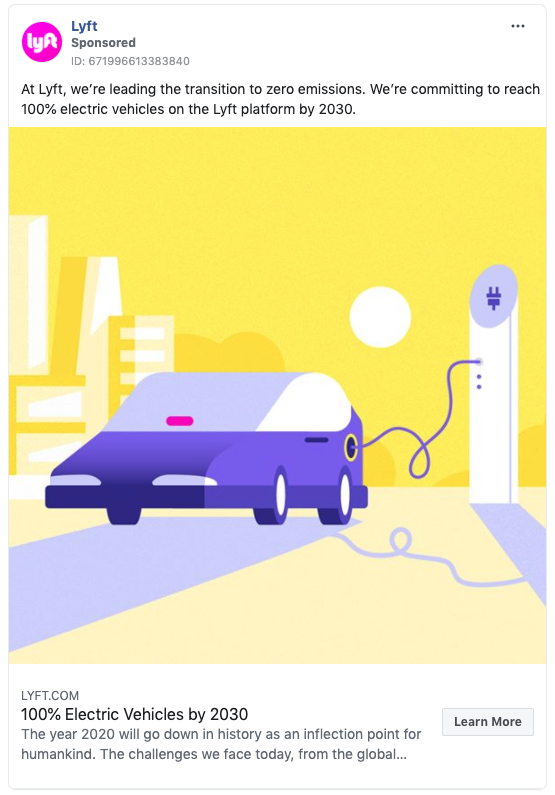Lyft, Inc. wants every vehicle on its platform to be gas-free and all-electric by 2030. This would mean that, by 2030, when a Lyft customer orders a ride, anywhere in the country, the vehicle will be entirely battery or hydrogen-powered. Electrifying its fleet could provide great financial and health benefits to both drivers and customers. But there’s a big difference between wanting something to happen and taking the steps needed to have it materialize. So far it is not clear that Lyft is committed to taking all the necessary measures.
|
Lyft ad for Facebook and Instagram |
That lack of commitment was apparent on the day of Lyft’s June 17 announcement. On a public video call with reporters, company president John Zimmer was noncommittal about whether Lyft would actually block gasoline vehicles from its service after 2030. And, a Lyft spokesperson told E&E News after the announcement that the company has “no plans to disallow drivers from using the Lyft platform if they don’t have an EV.” Despite this inconsistency, Lyft is running ads (image on the left) promoting its announcement. Running ads on a promise its leadership hasn’t committed to will mislead consumers.
|
What Lyft has promised to do is a good start. Announcing the intent to purchase electric vehicles for its car rental programs is important for consumer and driver savings, reducing pollution, and signaling a coming increase in market demand. And advocating for purchase and charging rebates is critical for creating a consumer-friendly marketplace. Together, these steps show leadership that companies — Uber in particular — should follow. But these promises by Lyft are not enough to ensure its electric aspirations are actually met. As of Spring 2019, only about 180,000 of Lyft’s 2 million or so drivers had used its car rental programs, such as ExpressDrive. Most drivers instead use personally-owned vehicles. So, without a roadmap for getting all its drivers into all-electric vehicles, Lyft’s plan lacks important details.
Lyft’s ambition to fully electrify its fleet by 2030 is admirable, but if it’s going to be successful, it needs to put its money where its mouth is. By hedging on its 2030 commitment, Lyft risks undermining its own effort to move the market. If Lyft expects this commitment to be taken seriously, the company needs to lay out how they will directly help drivers transition to electric vehicles, and when they will truly allow only electric vehicles to operate on their system.
If Lyft is serious, it should demonstrate its commitment by supporting government initiatives that would hold it accountable to its electric vehicle and greenhouse gas emissions goals. This includes backing California’s first-in-the-nation regulations for ride-hailing companies, known as the ‘Clean Miles Standard,’ which would compel Lyft and Uber to electrify much of its fleet over the next 10 years. It is critical for companies to commit to a zero-emissions future, and Lyft’s cautiousness reinforces the need for strong standards to hold these companies to their promises.
Electrifying ride-hailing fleets is critical to reducing air and climate pollution. In California, the average ride-hailing trip causes about 50% more pollution than the average car trip, per passenger mile, and many Lyft and Uber vehicles are driving significantly more miles than average. Consumer Reports is engaging with California’s Air Resources Board (CARB) as it develops the Clean Miles Standard for ride-hailing companies. California and other states should require ride-hailing companies to move towards an all-electric fleet to make sure consumers have the affordable and sustainable choices they deserve.
Lyft and Uber drivers who operate electric vehicles could potentially save hundreds of dollars on gas per month, so both consumers and drivers are poised to benefit from reduced operating costs. Electric vehicles (EVs) provide a great number of benefits to consumers, including lower operating costs, powerful performance, and a smooth, quiet ride, according to testing by Consumer Reports. The vehicles also produce no particulate or smog-causing tailpipe emissions, which are a significant contributor to asthma and other respiratory illnesses. EVs also reduce climate pollution, and in California produce on average 81% less greenhouse gas emissions than the average gas-powered vehicle, according to data from the U.S. Department of Energy.
With all of these benefits, electrifying ride-hailing has the potential to be a win, win, win for drivers, consumers, and the environment. Lyft should be commended for its all-electric aspirations, and regulations are needed to make sure they and other ride-hailing companies follow through on delivering these benefits.

